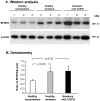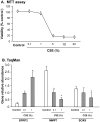Down-regulation of the canonical Wnt β-catenin pathway in the airway epithelium of healthy smokers and smokers with COPD
- PMID: 21490961
- PMCID: PMC3072378
- DOI: 10.1371/journal.pone.0014793
Down-regulation of the canonical Wnt β-catenin pathway in the airway epithelium of healthy smokers and smokers with COPD
Abstract
Background: The Wnt pathway mediates differentiation of epithelial tissues; depending on the tissue types, Wnt can either drive or inhibit the differentiation process. We hypothesized that key genes in the Wnt pathway are suppressed in the human airway epithelium under the stress of cigarette smoking, a stress associated with dysregulation of the epithelial differentiated state.
Methodology/principal findings: Microarrays were used to assess the expression of Wnt-related genes in the small airway epithelium (SAE) obtained via bronchoscopy and brushing of healthy nonsmokers, healthy smokers, and smokers with COPD. Thirty-three of 56 known Wnt-related genes were expressed in the SAE. Wnt pathway downstream mediators β-catenin and the transcription factor 7-like 1 were down-regulated in healthy smokers and smokers with COPD, as were many Wnt target genes. Among the extracellular regulators that suppress the Wnt pathway, secreted frizzled-related protein 2 (SFRP2), was up-regulated 4.3-fold in healthy smokers and 4.9-fold in COPD smokers, an observation confirmed by TaqMan Real-time PCR, Western analysis and immunohistochemistry. Finally, cigarette smoke extract mediated up-regulation of SFRP2 and down-regulation of Wnt target genes in airway epithelial cells in vitro.
Conclusions/significance: Smoking down-regulates the Wnt pathway in the human airway epithelium. In the context that Wnt pathway plays an important role in differentiation of epithelial tissues, the down-regulation of Wnt pathway may contribute to the dysregulation of airway epithelium differentiation observed in smoking-related airway disorders.
Conflict of interest statement
Figures








Similar articles
-
Canonical WNT pathway is activated in the airway epithelium in chronic obstructive pulmonary disease.EBioMedicine. 2020 Nov;61:103034. doi: 10.1016/j.ebiom.2020.103034. Epub 2020 Oct 10. EBioMedicine. 2020. PMID: 33045470 Free PMC article.
-
Down-regulation of the notch pathway in human airway epithelium in association with smoking and chronic obstructive pulmonary disease.Am J Respir Crit Care Med. 2009 Mar 15;179(6):457-66. doi: 10.1164/rccm.200705-795OC. Epub 2008 Dec 23. Am J Respir Crit Care Med. 2009. PMID: 19106307 Free PMC article.
-
Role of aberrant WNT signalling in the airway epithelial response to cigarette smoke in chronic obstructive pulmonary disease.Thorax. 2013 Aug;68(8):709-16. doi: 10.1136/thoraxjnl-2012-201667. Epub 2013 Jan 31. Thorax. 2013. PMID: 23370438
-
Reduced Frizzled Receptor 4 Expression Prevents WNT/β-Catenin-driven Alveolar Lung Repair in Chronic Obstructive Pulmonary Disease.Am J Respir Crit Care Med. 2017 Jul 15;196(2):172-185. doi: 10.1164/rccm.201605-0904OC. Am J Respir Crit Care Med. 2017. PMID: 28245136
-
Markers of anti-oxidant response in tobacco smoke exposed subjects: a data-mining review.Pulm Pharmacol Ther. 2010 Dec;23(6):482-92. doi: 10.1016/j.pupt.2010.05.006. Epub 2010 Jun 1. Pulm Pharmacol Ther. 2010. PMID: 20594977 Review.
Cited by
-
Wingless: developmentally important genes that respond adversely to smoking.Thorax. 2013 Aug;68(8):703-4. doi: 10.1136/thoraxjnl-2013-203249. Epub 2013 Apr 23. Thorax. 2013. PMID: 23611881 Free PMC article. No abstract available.
-
Human bronchial epithelial cells exposed in vitro to cigarette smoke at the air-liquid interface resemble bronchial epithelium from human smokers.Am J Physiol Lung Cell Mol Physiol. 2013 Apr 1;304(7):L489-503. doi: 10.1152/ajplung.00181.2012. Epub 2013 Jan 25. Am J Physiol Lung Cell Mol Physiol. 2013. PMID: 23355383 Free PMC article.
-
LRP5 in age-related changes in vascular and alveolar morphogenesis in the lung.Aging (Albany NY). 2019 Jan 5;11(1):89-103. doi: 10.18632/aging.101722. Aging (Albany NY). 2019. PMID: 30612120 Free PMC article.
-
WNT/RYK signaling restricts goblet cell differentiation during lung development and repair.Proc Natl Acad Sci U S A. 2019 Dec 17;116(51):25697-25706. doi: 10.1073/pnas.1911071116. Epub 2019 Nov 27. Proc Natl Acad Sci U S A. 2019. PMID: 31776260 Free PMC article.
-
Canonical WNT pathway is activated in the airway epithelium in chronic obstructive pulmonary disease.EBioMedicine. 2020 Nov;61:103034. doi: 10.1016/j.ebiom.2020.103034. Epub 2020 Oct 10. EBioMedicine. 2020. PMID: 33045470 Free PMC article.
References
-
- Knight DA, Holgate ST. The airway epithelium: structural and functional properties in health and disease. Respirology. 2003;8:432–446. - PubMed
Publication types
MeSH terms
Substances
Grants and funding
LinkOut - more resources
Full Text Sources
Medical
Molecular Biology Databases

